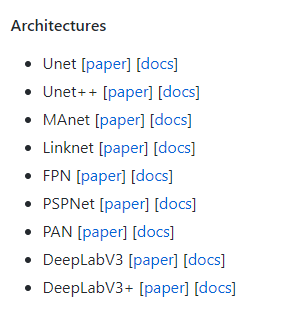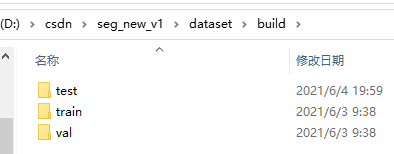参考链接1:GitHub链接:GitHub - qubvel/segmentation_models.pytorch: Segmentation models with pretrained backbones. PyTorch.
参考链接2:框架调用:https://github.com/WangZhenqing-RS/2021Tianchi_RS
链接1框架中模型包括以下几个,具体细节去原链接里看

这个语义分割框架包含了很多常见的模型,我这篇文章结合了下链接2他人在遥感大赛上的策略,调用了框架1的模型,虽然链接2已经可以直接用了,但我还是觉得使用起来要改的东西不少,我这里放一下使用起来相对简单点的版本,改动较大。使用之前最好去别人的原版下面好好看看,这些都是干嘛的,我保留了大部分策略,效果不错,把数据放好,模型选择下就可以直接训练
实际效果如下:
原图

标签:

预测结果:

精度评价:
acc: 0.9674116041666667
acc_cls: 0.9086168591905439
iou: [0.9643351 0.72580183]
miou: 0.8450684631527481
fwavacc: 0.939678139218996
class_recall: 0.8344991600686457
f1_score: 0.84111838934512851.数据准备(文件名字最好一致,不一致就去代码里改)
一级目录:

二级目录:

三级目录:里面就是图像和标签文件了,一一对应,名字相同
2.训练代码
segmentation_models_pytorch就是链接1,可以直接通过pip安装
pytorch_toolbelt也需要安装
# -*- coding: utf-8 -*-
import time
import warnings
import numpy as np
from tqdm import tqdm
import torch
import torch.nn as nn
from torch.optim.swa_utils import AveragedModel, SWALR
import segmentation_models_pytorch as smp
from segmentation_models_pytorch.losses import DiceLoss, SoftCrossEntropyLoss, LovaszLoss
from pytorch_toolbelt import losses as L
from data import ImageFolder
warnings.filterwarnings('ignore')
torch.backends.cudnn.enabled = True
DEVICE = 'cuda:0' if torch.cuda.is_available() else 'cpu'
def iou_pytorch(outputs: torch.Tensor, labels: torch.Tensor, SMOOTH = 1e-6):
# You can comment out this line if you are passing tensors of equal shape
# But if you are passing output from UNet or something it will most probably
# be with the BATCH x 1 x H x W shape
outputs = outputs.squeeze(1) # BATCH x 1 x H x W => BATCH x H x W
intersection = (outputs & labels).float().sum((1, 2)) # Will be zero if Truth=0 or Prediction=0
union = (outputs | labels).float().sum((1, 2)) # Will be zzero if both are 0
iou = (intersection + SMOOTH) / (union + SMOOTH) # We smooth our devision to avoid 0/0
thresholded = torch.clamp(20 * (iou - 0.5), 0, 10).ceil() / 10 # This is equal to comparing with thresolds
return thresholded.mean() # Or thresholded.mean() if you are interested in average across the batch
def train(EPOCHES, BATCH_SIZE, data_root, channels, optimizer_name,
model_path, swa_model_path, loss, early_stop):
train_dataset = ImageFolder(data_root, mode='train')
val_dataset = ImageFolder(data_root, mode='val')
train_data_loader = torch.utils.data.DataLoader(
train_dataset,
batch_size = BATCH_SIZE,
shuffle=True,
num_workers=0)
val_data_loader = torch.utils.data.DataLoader(
val_dataset,
batch_size = BATCH_SIZE,
shuffle=True,
num_workers=0)
# 定义模型,优化器,损失函数
# model = smp.UnetPlusPlus(
# encoder_name="efficientnet-b7",
# encoder_weights="imagenet",
# in_channels=channels,
# classes=10,
# )
# model = smp.UnetPlusPlus(
# encoder_name="timm-resnest101e",
# encoder_weights="imagenet",
# in_channels=channels,
# classes=2,
# )
#这里用UNET试试,注意二分类,classes应该是1
model = smp.Unet(
encoder_name="resnet34", # choose encoder, e.g. mobilenet_v2 or efficientnet-b7
encoder_weights="imagenet", # use `imagenet` pre-trained weights for encoder initialization
in_channels=channels, # model input channels (1 for gray-scale images, 3 for RGB, etc.)
classes=1, # model output channels (number of classes in your dataset)
activation='sigmoid', #二分类需要换成sigmoid
)
model.to(DEVICE);
# model.load_state_dict(torch.load(model_path))
if(optimizer_name == "sgd"):
optimizer = torch.optim.SGD(model.parameters(),
lr=1e-4, weight_decay=1e-3, momentum=0.9)
else:
optimizer = torch.optim.AdamW(model.parameters(),
lr=1e-3, weight_decay=1e-3)
# 余弦退火调整学习率
scheduler = torch.optim.lr_scheduler.CosineAnnealingWarmRestarts(
optimizer,
T_0=2, # T_0就是初始restart的epoch数目
T_mult=2, # T_mult就是重启之后因子,即每个restart后,T_0 = T_0 * T_mult
eta_min=1e-5 # 最低学习率
)
if(loss == "SoftCE_dice"): #mode: Loss mode 'binary', 'multiclass' or 'multilabel'
# 损失函数采用SoftCrossEntropyLoss+DiceLoss
# diceloss在一定程度上可以缓解类别不平衡,但是训练容易不稳定
DiceLoss_fn = DiceLoss(mode='binary') #多分类改为multiclass
Bceloss_fn = nn.BCELoss()
# 软交叉熵,即使用了标签平滑的交叉熵,会增加泛化性
# SoftCrossEntropy_fn=SoftCrossEntropyLoss(smooth_factor=0.1) #用于多分类
loss_fn = L.JointLoss(first=DiceLoss_fn, second=Bceloss_fn, first_weight=0.5, second_weight=0.5).cuda()
else:
# 损失函数采用SoftCrossEntropyLoss+LovaszLoss
# LovaszLoss是对基于子模块损失凸Lovasz扩展的mIoU损失的直接优化
LovaszLoss_fn = LovaszLoss(mode='binary')
# 软交叉熵,即使用了标签平滑的交叉熵,会增加泛化性
SoftCrossEntropy_fn=SoftCrossEntropyLoss(smooth_factor=0.1) #这里我没有改,这里是多分类的,有需求就改下
loss_fn = L.JointLoss(first=LovaszLoss_fn, second=SoftCrossEntropy_fn,
first_weight=0.5, second_weight=0.5).cuda()
best_miou = 0
best_miou_epoch = 0
train_loss_epochs, val_mIoU_epochs, lr_epochs = [], [], []
for epoch in range(1, EPOCHES+1):
losses = []
start_time = time.time()
model.train()
model.to(DEVICE)
for image, target in tqdm(train_data_loader, ncols=20, total=len(train_data_loader)):
image, target = image.to(DEVICE), target.to(DEVICE)
optimizer.zero_grad()
output = model(image)
loss = loss_fn(output, target)
loss.backward()
optimizer.step()
losses.append(loss.item())
scheduler.step()
val_iou = []
val_data_loader_num = iter(val_data_loader)
for val_img, val_mask in tqdm(val_data_loader_num,ncols=20,total=len(val_data_loader_num)):
val_img, label = val_img.to(DEVICE), val_mask.to(DEVICE)
predict = model(val_img)
predict[predict >= 0.5] = 1
predict[predict < 0.5] = 0
predict = predict.type(torch.LongTensor)
label = label.squeeze(1).type(torch.LongTensor)
iou = iou_pytorch(predict, label)
val_iou.append(iou)
train_loss_epochs.append(np.array(losses).mean())
val_mIoU_epochs.append(np.mean(val_iou))
lr_epochs.append(optimizer.param_groups[0]['lr'])
print('Epoch:' + str(epoch) + ' Loss:' + str(np.array(losses).mean()) + ' Val_IOU:' + str(np.mean(val_iou)) + ' Time_use:' + str((time.time()-start_time)/60.0))
if best_miou < np.stack(val_iou).mean(0).mean():
best_miou = np.stack(val_iou).mean(0).mean()
best_miou_epoch = epoch
torch.save(model.state_dict(), model_path)
print(" valid mIoU is improved. the model is saved.")
else:
print("")
if (epoch - best_miou_epoch) >= early_stop:
break
return train_loss_epochs, val_mIoU_epochs, lr_epochs
if __name__ == '__main__':
EPOCHES = 500
BATCH_SIZE = 8
loss = "SoftCE_dice"
#loss = "SoftCE_Lovasz"
channels = 3
optimizer_name = "adamw"
data_root = "./dataset/build/"
model_path = "./weights/"
model_path += "_" + loss
swa_model_path = model_path + "_swa.pth"
model_path += ".pth"
early_stop = 400
train_loss_epochs, val_mIoU_epochs, lr_epochs = train(EPOCHES, BATCH_SIZE, data_root, channels, optimizer_name, model_path, swa_model_path, loss,early_stop)
if(True):
import matplotlib.pyplot as plt
epochs = range(1, len(train_loss_epochs) + 1)
plt.plot(epochs, train_loss_epochs, 'r', label = 'train loss')
plt.plot(epochs, val_mIoU_epochs, 'b', label = 'val mIoU')
plt.title('train loss and val mIoU')
plt.legend()
plt.savefig("train loss and val mIoU.png",dpi = 300)
plt.figure()
plt.plot(epochs, lr_epochs, 'r', label = 'learning rate')
plt.title('learning rate')
plt.legend()
plt.savefig("learning rate.png", dpi = 300)
plt.show()
下面是链接1中激活函数的位置,可以选择的很多,二分类用的是sigmoid

不同的模型需要填写的参数可能不同,可能需要去链接1里的模型位置好好看下,具体链接:https://github.com/qubvel/segmentation_models.pytorch/tree/master/segmentation_models_pytorch
以deeplabV3为例,模型结构的位置如下
可调整的参数就在初始化的地方,找到位置好好看下就行了

3.数据加载代码data.py
注意下,这里数据加载我resize了,不需要的可以注释掉,在own_data_loader和own_data_test_loader中
# -*- coding: utf-8 -*-
import torch
import torch.utils.data as data
from torch.autograd import Variable as V
from PIL import Image
import cv2
import numpy as np
import os
import scipy.misc as misc
def randomHueSaturationValue(image, hue_shift_limit=(-180, 180),
sat_shift_limit=(-255, 255),
val_shift_limit=(-255, 255), u=0.5):
if np.random.random() < u:
image = cv2.cvtColor(image, cv2.COLOR_BGR2HSV)
h, s, v = cv2.split(image)
hue_shift = np.random.randint(hue_shift_limit[0], hue_shift_limit[1]+1)
hue_shift = np.uint8(hue_shift)
h += hue_shift
sat_shift = np.random.uniform(sat_shift_limit[0], sat_shift_limit[1])
s = cv2.add(s, sat_shift)
val_shift = np.random.uniform(val_shift_limit[0], val_shift_limit[1])
v = cv2.add(v, val_shift)
image = cv2.merge((h, s, v))
#image = cv2.merge((s, v))
image = cv2.cvtColor(image, cv2.COLOR_HSV2BGR)
return image
def randomShiftScaleRotate(image, mask,
shift_limit=(-0.0, 0.0),
scale_limit=(-0.0, 0.0),
rotate_limit=(-0.0, 0.0),
aspect_limit=(-0.0, 0.0),
borderMode=cv2.BORDER_CONSTANT, u=0.5):
if np.random.random() < u:
height, width, channel = image.shape
angle = np.random.uniform(rotate_limit[0], rotate_limit[1])
scale = np.random.uniform(1 + scale_limit[0], 1 + scale_limit[1])
aspect = np.random.uniform(1 + aspect_limit[0], 1 + aspect_limit[1])
sx = scale * aspect / (aspect ** 0.5)
sy = scale / (aspect ** 0.5)
dx = round(np.random.uniform(shift_limit[0], shift_limit[1]) * width)
dy = round(np.random.uniform(shift_limit[0], shift_limit[1]) * height)
cc = np.math.cos(angle / 180 * np.math.pi) * sx
ss = np.math.sin(angle / 180 * np.math.pi) * sy
rotate_matrix = np.array([[cc, -ss], [ss, cc]])
box0 = np.array([[0, 0], [width, 0], [width, height], [0, height], ])
box1 = box0 - np.array([width / 2, height / 2])
box1 = np.dot(box1, rotate_matrix.T) + np.array([width / 2 + dx, height / 2 + dy])
box0 = box0.astype(np.float32)
box1 = box1.astype(np.float32)
mat = cv2.getPerspectiveTransform(box0, box1)
image = cv2.warpPerspective(image, mat, (width, height), flags=cv2.INTER_LINEAR, borderMode=borderMode,
borderValue=(
0, 0,
0,))
mask = cv2.warpPerspective(mask, mat, (width, height), flags=cv2.INTER_LINEAR, borderMode=borderMode,
borderValue=(
0, 0,
0,))
return image, mask
def randomHorizontalFlip(image, mask, u=0.5):
if np.random.random() < u:
image = cv2.flip(image, 1)
mask = cv2.flip(mask, 1)
return image, mask
def randomVerticleFlip(image, mask, u=0.5):
if np.random.random() < u:
image = cv2.flip(image, 0)
mask = cv2.flip(mask, 0)
return image, mask
def randomRotate90(image, mask, u=0.5):
if np.random.random() < u:
image=np.rot90(image)
mask=np.rot90(mask)
return image, mask
def default_loader(img_path, mask_path):
img = cv2.imread(img_path)
# print("img:{}".format(np.shape(img)))
img = cv2.resize(img, (448, 448))
mask = cv2.imread(mask_path, cv2.IMREAD_GRAYSCALE)
mask = 255. - cv2.resize(mask, (448, 448))
img = randomHueSaturationValue(img,
hue_shift_limit=(-30, 30),
sat_shift_limit=(-5, 5),
val_shift_limit=(-15, 15))
img, mask = randomShiftScaleRotate(img, mask,
shift_limit=(-0.1, 0.1),
scale_limit=(-0.1, 0.1),
aspect_limit=(-0.1, 0.1),
rotate_limit=(-0, 0))
img, mask = randomHorizontalFlip(img, mask)
img, mask = randomVerticleFlip(img, mask)
img, mask = randomRotate90(img, mask)
mask = np.expand_dims(mask, axis=2)
#
# print(np.shape(img))
# print(np.shape(mask))
img = np.array(img, np.float32).transpose(2,0,1)/255.0 * 3.2 - 1.6
mask = np.array(mask, np.float32).transpose(2,0,1)/255.0
mask[mask >= 0.5] = 1
mask[mask <= 0.5] = 0
#mask = abs(mask-1)
return img, mask
def read_own_data(root_path, mode = 'train'):
images = []
masks = []
image_root = os.path.join(root_path, mode + '/images')
gt_root = os.path.join(root_path, mode + '/labels')
for image_name in os.listdir(gt_root):
image_path = os.path.join(image_root, image_name)
label_path = os.path.join(gt_root, image_name)
images.append(image_path)
masks.append(label_path)
return images, masks
def own_data_loader(img_path, mask_path):
img = cv2.imread(img_path)
img = cv2.resize(img, (512,512), interpolation = cv2.INTER_NEAREST)
mask = cv2.imread(mask_path, 0)
mask = cv2.resize(mask, (512,512), interpolation = cv2.INTER_NEAREST)
img = randomHueSaturationValue(img,
hue_shift_limit=(-30, 30),
sat_shift_limit=(-5, 5),
val_shift_limit=(-15, 15))
img, mask = randomShiftScaleRotate(img, mask,
shift_limit=(-0.1, 0.1),
scale_limit=(-0.1, 0.1),
aspect_limit=(-0.1, 0.1),
rotate_limit=(-0, 0))
img, mask = randomHorizontalFlip(img, mask)
img, mask = randomVerticleFlip(img, mask)
img, mask = randomRotate90(img, mask)
mask = np.expand_dims(mask, axis=2)
img = np.array(img, np.float32) / 255.0 * 3.2 - 1.6
# img = np.array(img, np.float32) / 255.0
mask = np.array(mask, np.float32) / 255.0
mask[mask >= 0.5] = 1
mask[mask < 0.5] = 0
img = np.array(img, np.float32).transpose(2, 0, 1)
mask = np.array(mask, np.float32).transpose(2, 0, 1)
return img, mask
def own_data_test_loader(img_path, mask_path):
img = cv2.imread(img_path)
img = cv2.resize(img, (512,512), interpolation = cv2.INTER_NEAREST)
mask = cv2.imread(mask_path, 0)
mask = cv2.resize(mask, (512,512), interpolation = cv2.INTER_NEAREST)
mask = np.expand_dims(mask, axis=2)
img = np.array(img, np.float32) / 255.0 * 3.2 - 1.6
mask = np.array(mask, np.float32) / 255.0
mask[mask >= 0.5] = 1
mask[mask < 0.5] = 0
img = np.array(img, np.float32).transpose(2, 0, 1)
mask = np.array(mask, np.float32).transpose(2, 0, 1)
return img, mask
class ImageFolder(data.Dataset):
def __init__(self,root_path, mode='train'):
self.root = root_path
self.mode = mode
self.images, self.labels = read_own_data(self.root, self.mode)
def __getitem__(self, index):
if self.mode == 'test':
img, mask = own_data_test_loader(self.images[index], self.labels[index])
else:
img, mask = own_data_loader(self.images[index], self.labels[index])
img = torch.Tensor(img)
mask = torch.Tensor(mask)
return img, mask
def __len__(self):
assert len(self.images) == len(self.labels), 'The number of images must be equal to labels'
return len(self.images)4.预测代码inference.py
预测只用了test_1函数,保留了原作者的多模型预测函数test,感兴趣的朋友改改试试看
# -*- coding: utf-8 -*-
import os
import glob
import time
import cv2
import numpy as np
import torch
import segmentation_models_pytorch as smp
from torch.optim.swa_utils import AveragedModel
from data import ImageFolder
DEVICE = 'cuda:0' if torch.cuda.is_available() else 'cpu'
def test(model_path_effi7, model_path_resnest, output_dir, test_loader):
in_channels = 4
model_resnest = smp.UnetPlusPlus(
encoder_name="timm-resnest101e",
encoder_weights="imagenet",
in_channels=in_channels,
classes=10,
)
model_effi7 = smp.UnetPlusPlus(
encoder_name="efficientnet-b7",
encoder_weights="imagenet",
in_channels=in_channels,
classes=10,
)
# 如果模型是SWA
if("swa" in model_path_resnest):
model_resnest = AveragedModel(model_resnest)
if("swa" in model_path_effi7):
model_effi7 = AveragedModel(model_effi7)
model_resnest.to(DEVICE);
model_resnest.load_state_dict(torch.load(model_path_resnest))
model_resnest.eval()
model_effi7.to(DEVICE);
model_effi7.load_state_dict(torch.load(model_path_effi7))
model_effi7.eval()
for image, image_stretch, image_path, ndvi in test_loader:
with torch.no_grad():
# image.shape: 16,4,256,256
image_flip2 = torch.flip(image,[2])
image_flip2 = image_flip2.cuda()
image_flip3 = torch.flip(image,[3])
image_flip3 = image_flip3.cuda()
image = image.cuda()
image_stretch = image_stretch.cuda()
output1 = model_resnest(image).cpu().data.numpy()
output2 = model_resnest(image_stretch).cpu().data.numpy()
output3 = model_effi7(image).cpu().data.numpy()
output4 = model_effi7(image_stretch).cpu().data.numpy()
output5 = torch.flip(model_resnest(image_flip2),[2]).cpu().data.numpy()
output6 = torch.flip(model_effi7(image_flip2),[2]).cpu().data.numpy()
output7 = torch.flip(model_resnest(image_flip3),[3]).cpu().data.numpy()
output8 = torch.flip(model_effi7(image_flip3),[3]).cpu().data.numpy()
output = (output1 + output2 + output3 + output4 + output5 + output6 + output7 + output8) / 8.0
# output.shape: 16,10,256,256
for i in range(output.shape[0]):
pred = output[i]
# for low_ndvi in range(3,8):
# pred[low_ndvi][ndvi[i]>35] = 0
# for high_ndvi in range(3):
# pred[high_ndvi][ndvi[i]<0.02] = 0
pred = np.argmax(pred, axis = 0) + 1
pred = np.uint8(pred)
save_path = os.path.join(output_dir, image_path[i][-10:].replace('.tif', '.png'))
print(save_path)
cv2.imwrite(save_path, pred)
def test_1(channels, model_path, output_dir, test_path):
# model = smp.UnetPlusPlus(
# encoder_name="resnet101",
# encoder_weights="imagenet",
# in_channels=4,
# classes=10,
# )
# model = smp.DeepLabV3Plus(
# encoder_name="resnet101",
# encoder_weights="imagenet",
# in_channels=in_channels,
# classes=1,
# )
model = smp.Unet(
encoder_name="resnet34", # choose encoder, e.g. mobilenet_v2 or efficientnet-b7
encoder_weights="imagenet", # use `imagenet` pre-trained weights for encoder initialization
in_channels=channels, # model input channels (1 for gray-scale images, 3 for RGB, etc.)
classes=1, # model output channels (number of classes in your dataset)
activation='sigmoid',
)
# 如果模型是SWA
if("swa" in model_path):
model = AveragedModel(model)
model.to(DEVICE);
model.load_state_dict(torch.load(model_path))
model.eval()
im_names = os.listdir(test_path)
for name in im_names:
full_path = os.path.join(test_path, name)
img = cv2.imread(full_path)
img = cv2.resize(img, (512,512), interpolation = cv2.INTER_NEAREST)
image = np.array(img, np.float32) / 255.0 * 3.2 - 1.6
image = np.array(image, np.float32).transpose(2, 0, 1)
image = np.expand_dims(image, axis=0)
image = torch.Tensor(image)
image = image.cuda()
output = model(image).cpu().data.numpy()
output[output < 0.5] = 0
output[output >= 0.5] = 255
output = output.squeeze()
save_path = os.path.join(output_dir, name)
cv2.imwrite(save_path, output)
if __name__ == "__main__":
start_time = time.time()
# model_path_effi7 = "../user_data/model_data/unetplusplus_effi7_upsample_SoftCE_dice.pth"
# model_path_resnest = "../user_data/model_data/unetplusplus_resnest_upsample_SoftCE_dice.pth"
data_root = "./dataset/build/test/images/"
model_path = "./weights/_SoftCE_dice.pth"
output_dir = './result/'
test_1(3, model_path, output_dir, data_root)
题外话:有什么新的比较好的网络可以评论推荐给我,我来复现贴出来大家一起用一用
























 897
897











 被折叠的 条评论
为什么被折叠?
被折叠的 条评论
为什么被折叠?










